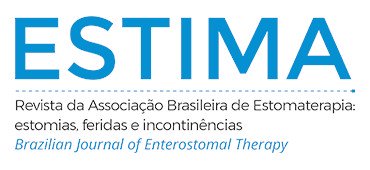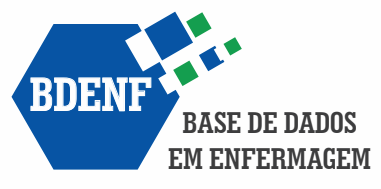Larval therapy from the patient’s perspective
Abstract
Objective: to describe the perception of the patient undergoing larval therapy. Method: qualitative, exploratory-descriptive study, using oral history as a data collection technique and methodological framework, in the form of oral life history. Six patients with difficult-to-heal wounds participated in the study, followed by the dressing committee of a teaching hospital in Natal, Rio Grande do Norte, undergoing larval therapy. Results: the testimonies of the patients/collaborators point to various values, such as belief, fear, acceptance, improvement of the wound and pain. They revealed that there is no major objection and that clarification regarding the treatment instituted proved to be important in the acceptance decision. Conclusion: the feelings expressed by the patients, such as improvement of the wound, reduction of pain and odor, optimization of the healing process, emergence of sparks of hope regarding the return to their life, among others, translate the benefits of Larval Therapy (LT). Despite the seizure caused by the animal’s movement over the affected area and the disgust it causes to some professionals and people, LT was considered wonderful, especially for its effectiveness in cleaning the wound without the need for new invasive procedures such as cutting and surgical debridement.
Downloads
Metrics
References
Ferreira GE, Costa CO, Richter AS, Santos EP, Kaiser DE, Duarte ER. Concepções multiprofissionais sobre a integralidade no cuidado à pessoa com lesão de pele. Rev En-fermagem Brasil [Online].2017 Abril/Set. [Acesso 07 de setembro de 2020];16(5):259-266 disponível em: https://www.researchgate.net/publication/328175949
Gomes E, Donoso M, Alvarenga A, Gouveia R. Compreendendo os significados de se conviver com ferida crônica. Rev Enferm Atenção Saúde [Online]. 2018 Ago/Set. [Acesso 30 de agosto de 2020]; 7(2):176-188 disponível em: https://doi:10.18554/reas.v7i2.2396
Oliveira APBS, Peripato LA. A cobertura ideal para tratamento em paciente queimado: uma revisão integrativa da literatura. Rev Bras Queimaduras [Online].2017. [Acesso 12 de setembro de 2020]; 16(3):188-93 disponivel em: http://www.rbqueimaduras.com.br/details/392/pt-BR/
Marques R, Veludo FA. Competências do Gestor de Feridas: scoping review. Rev Ga-úcha Enferm [Online]. 2019 [Acesso 07 de setembro de 2020];40 (20): 180-421. Dis-ponível em: https://doi.org/10.1590/1983-1447.2019.20180421
Silva ACO, Filho ESR, Souza GRS, Silva JFS, Silva AL, Araújo CMS. As principais coberturas utilizadas pelo enfermeiro. Revista Uningá [Online]. 2017 Jul-Set [Acesso 08 de agosto de 2020] 53 (2) 117-123 disponível em: https://www.mastereditora.com.br/periodico/20170806_101051
Franco LC, Franco WC, Barros SBL, Araújo CM, Rezende HHA. Aceitabilidade da terapia larval no tratamento de feridas. Revista Científica de Enferma-gem[Online].2016. Maio/Jul [Acesso 06 de setembro de 2020]; 6(17) 13-18. Disponível em: https://www.recien.com.br/index.php/Recien/article/download/144/217
Masiero FS, Martins DS, Thyssen PJ. Terapia Larval e a aplicação de larvas para cica-trização: revisão e estado da arte no Brasil e no mundo. Revista Thema [Online].2015. Dez [Acesso 06 de setembro de 2020] 12 (01) 4-14. Disponível em: https://www.researchgate.net/publication/293193664.
Marcondes CB. Terapia larval de lesões de pele causadas por diabetes e outras doen-ças. Florianópolis: editora UFSC, 2006. 88p.
Fonseca MA, Sarmiento JH.; Pérez PR.; Thyssen PJ, Sherman R. Clinical study of Maggot therapy for Fournier's gangrene. International Wound Journal [Online].2020. Jul [Acesso 06 de setembro de 2020] 1-18. Disponível: https://doi.org/10.1111/iwj.13444
IBS (International Biotherapy Society). Disponível em http://biotherapysociety.org/maggot-debridement-therapy-mdt/. [Acesso 06 de setem-bro de 2020].
Pinheiro MARQ, Ferraz JB, Junior MAA, Moura AD, da Costa MESM, Costa FJMD, et al. Use of maggot therapy for treating a diabetic foot ulcer colonized by multidrug resistant bacteria in Brazil. Indian J Med Res [Online]. 2015. Marc [Acesso 06 de se-tembro de 2020]; 141(3), 340–2. Disponível em: http://www.ijmr.org.in/text.asp?2015/141/3/340/156628
Ferraz JB, Pinheiro M, Gama RA. Biocirurgia. In: BLANK M,GIANNINI T organi-zadores. Úlceras e Feridas: as feridas tem alma. Rio de Janeiro: Di Livros, 2014. 864p.
Brambilla PBT. Terapia larval e Divulgação Científica no Brasil: Até quando serão ne-gligenciadas? Natal, RN: Universidade Federal do Rio Grande do Norte, 2018. Traba-lho de Conclusão de Curso em Ciências Biológicas. Disponível em: https://monografias.ufrn.br/
Meihy JCSB. Manual de História oral. 5.ed. São Paulo: Loyola, 2005.V 1. 291p. ___________, HOLANDA F. História oral: como fazer, como pensar. 3 edição. São Paulo- SP: Contexto, 2015.P 169
Santos ASR. A importância da vocalização na identificação das aves. Bol. CEO. São Paulo, n.10, p.27-33. 1994. Disponível em: http://www.ceo.org.br/bolet/bolceo10.pdf Acesso em: 07 set.2020.
Sherman R. Mechanisms of maggot-induced wound healing: what do we know, and where do we go from here? Evidence-based Complementary and AlternativeMedicine [Online] 2014. Março [Acesso 06 de setembro de 2020]; 2014(2) 1-13. Disponivel em: http://dx.doi.org/10.1155/2014/592419
Masiero FS, Aquino MFK, Nassu MP, Pereira DIB, Leite DS, Thyssen PJ. First record of larval secretions of Cochliomyia macellaria (Fabricius, 1775) (Diptera: Calliphori-dae) inhibiting the growth of Staphylococcus aureus and Pseudomonas aeruginosa. Neotropical Entomology [Online] 2017. Outubro [Acesso 06 de setembro de 2020]; 46 (1) 1-5.Disponivel em: https://doi.org/10.1007/s13744-016-0444-4
Masiero FS, Silva DG, Luche M, Estércio T, Pérsio, NV, Thyssen, PJ. In vitro evalua-tion of the association of medicinal larvae (Insecta, Diptera, Calliphoridae) and topical agents conventionally used for the treatment of wounds. Acta Tropical. [Online] 2019. Fevereiro. [Acesso 06 de setembro de 2020]; 190. 68-72. Disponivel em: https://doi.org/10.1016/j.actatropica.2018.10.015
Masiero FS, Aguiar ESV, Pereira DIB, Thyssen PJ. First Report on the Use of Larvae of Cochliomyia macellaria (Diptera: Calliphoridae) for Wound Treatment in Veteri-nary Practice. Journal of Medical Entomology [Online]. 2020.Maio. [Acesso 06 de se-tembro de 2020] 57(3), 965-968. Disponível em: https://doi.org/10.1093/jme/tjz238
Fonseca-Muñoz A, Sarmiento-Jiménez H.E, Pérez-Pacheco R, thyssen PJ, Sherman R. Clinical study of Maggot therapy for Fournier's gangrene. International Wound Journal [Online]. 2020. Març/Jun [Acesso 06 de setembro de 2020] 1-8. Disponível em: https://doi.org/10.1111/iwj.13444
Tolfo GR, Lohmann MP, Costa AEK, Marchese C. Nurse's performance in the care of chronic wounds in Primary Health Care: integrative review [Online]. 2020. Maio. [Acesso 30 de setembro de 2020] 9(7) 1-17. Disponivel em: : http://dx.doi.org/10.33448/rsd-v9i7.
Downloads
Published
How to Cite
Issue
Section
License
Copyright (c) 2020 Simone Maria da Silva, Rejane Medeiros Millions, Rita de Cássia Almeida , João Evangelista da Costa

This work is licensed under a Creative Commons Attribution 4.0 International License.

























